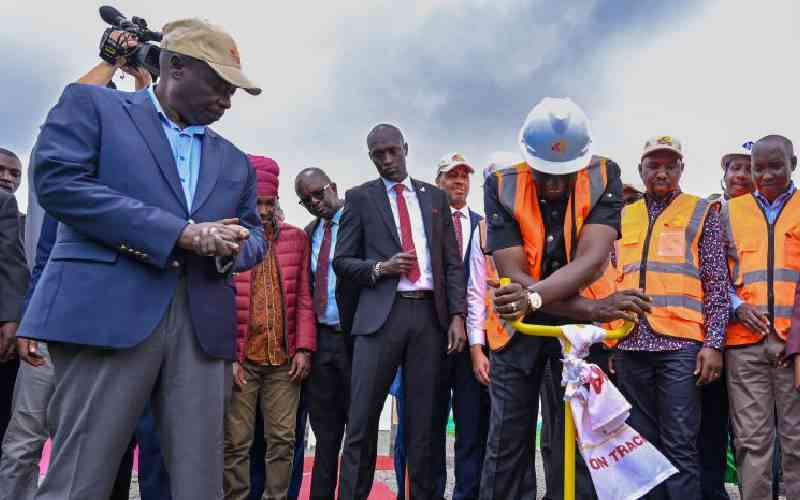By Nunn Asa
It will soon take you 15 minutes to travel from Syokimau to Nairobi’s city centre instead of the many hours spent in traffic snarl-ups on Mombasa Road.
This follows the completion of the first phase of the Nairobi Commuter Rail (NCR) project that includes a new commuter railway station at Syokimau and a two-kilometre line connecting it to the old Embakasi line.
Initial tests early this week saw the train take 15 minutes from the Syokimau station to the central business district, a distance that usually takes motorist close to an hour at rush hour.
The plan is set to reduce Nairobi’s reliance on matatu transport and eliminate traffic jams in the city with master plans including the proposed construction of new lines to satellite towns such as Ngong, Kiserian and Kikuyu. Four stations are scheduled
to be constructed, according to the Nairobi urban transport master plan under the Vision 2030 and two of them, Imara-Daima and Makadara are under construction with the latter expected to be twice the size of Syokimau.
The Sh200 million-rail line is the first Kenya has built since the Second World War. It is part of the larger Sh24 billion urban transport network that will connect Nairobi’s estates with the Central Business District.
The new service is targeting commuters from Syokimau, Kitengela, Athi River Machakos and Mombasa Road.
According to G G Tatache, Kenya Railways General Manager Corporate Affairs the commuter train and electronic ticketing is expected to move 10,000 to 20,000 passengers daily.
Ease access
The station set to start operations in August is the first intercity connection with all amenities aimed at decongesting Mombasa Road as well as ease access to the city. Additionally, the project will also open up new opportunities for employment and housing.
“This first phase of the new railway will be served by six refurbished coaches, although in the long run there will be 20 coaches, each with a capacity of 200 passengers.”
“The network will see two trains moving in different directions handling an increased capacity of 60 million passengers annually up from the current five million,” says Mr Tatache.
He says Kenya Railways is working on the preferred schedule and cost and adds that he is optimistic there will be increased frequency of trips between the (CBD) and its outskirts to effectively deal with the traffic snarl-ups.
He also adds that the corporation has already established 2,500 parking spaces that will be available at a small fee at the Syokimau station complete with vehicle servicing centres and a petrol station. This capacity, however, he says is set to increase with time.
Stay informed. Subscribe to our newsletter
Security risks
This project will also see Kenya Railways Corporation build a new six-kilometre line connecting Embakasi to Jomo Kenyatta International Airport (JKIA). This development will not only benefit residents but also visitors getting into or leaving the country through the airport. Many times they get stuck in traffic along the busy Mombasa Road just a few minutes on their way to or from the airport.
Many motorists have welcomed the idea saying it will help curb millions of shillings lost in productivity, fuel consumption and pollution. Saying the project if properly managed will provide reliable, safe and affordable commuter services in Nairobi.
However officials from the Kenya Railways say the benefits of the new rail commuter system may be cancelled out by the large population of slum dwellers living along the railway line at the Mukuru since they could pose security and safety challenges.
Kenya Railways is also wary of the challenge posed by the matatu bus station as many middle class and high class commuters would stay away from the City Centre Railway Station owing to overcrowding and the risk of being pick pocketed.
“There is no point of spending 15 minutes from the airport to the CBD just to spend another two hours in movement within the city station because of the matatu madness at the Railways Bus stop,” says Mr Tatache.
He says there are plans to decongest the stage and do away with the menace explaining that dedicated taxis and city transportation will be established to move people from the city terminal.
“We are speaking with officials in the Local Government ministry so that the matatus can be shifted to an alternative place. We want to ease the hustles and the menace posed by touts on train commuters,” Tatache adds.
Adherence to capacity
The idea has been welcomed by a number of residents although many are skeptical on their security.
“The idea is very good. But how am I expected to leave the comfort of my car and take the train when I am not sure if I will be able to talk freely on phone let alone reach my destination with my wallet intact?” Asks Kongo Onyalo, a motorist.
He hopes the couches will have different classes and strict adherence to capacity to avoid overloading, which is common in the current commuter train coaches. The introduction of this railway service to the city centre will greatly ease traffic jams on Mombasa Road.
Tales abound of motorists who have spent several hours in traffic on this notorious road. These traffic jams experienced during peak hours have become part of Nairobi’s identity, affecting all key roads and major arteries within the CBD and its outskirts.
 The Standard Group Plc is a
multi-media organization with investments in media platforms spanning newspaper
print operations, television, radio broadcasting, digital and online services. The
Standard Group is recognized as a leading multi-media house in Kenya with a key
influence in matters of national and international interest.
The Standard Group Plc is a
multi-media organization with investments in media platforms spanning newspaper
print operations, television, radio broadcasting, digital and online services. The
Standard Group is recognized as a leading multi-media house in Kenya with a key
influence in matters of national and international interest.
 The Standard Group Plc is a
multi-media organization with investments in media platforms spanning newspaper
print operations, television, radio broadcasting, digital and online services. The
Standard Group is recognized as a leading multi-media house in Kenya with a key
influence in matters of national and international interest.
The Standard Group Plc is a
multi-media organization with investments in media platforms spanning newspaper
print operations, television, radio broadcasting, digital and online services. The
Standard Group is recognized as a leading multi-media house in Kenya with a key
influence in matters of national and international interest.






